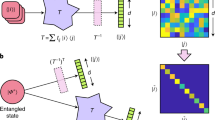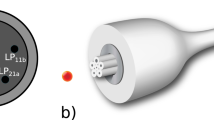Abstract
Current optical fibre transmission systems rely on modulation, coding and multiplexing techniques that were originally developed for linear communication channels. However, linear transmission techniques are not fully compatible with a transmission medium with a nonlinear response, which is the case for an optical fibre. As a consequence, the Kerr nonlinearity in fibre imposes a limit on the performance and the achievable transmission rate of the conventional optical fibre communication systems. Here we show that a transmission performance beyond the conventional Kerr nonlinearity limit can be achieved by encoding all the available degrees of freedom and nonlinearly multiplexing signals in the so-called nonlinear Fourier spectrum, which evolves linearly along the fibre link. This result strongly motivates a fundamental paradigm shift in modulation, coding and signal-processing techniques for optical fibre transmission technology.
This is a preview of subscription content, access via your institution
Access options
Access Nature and 54 other Nature Portfolio journals
Get Nature+, our best-value online-access subscription
$29.99 / 30 days
cancel any time
Subscribe to this journal
Receive 12 print issues and online access
$209.00 per year
only $17.42 per issue
Buy this article
- Purchase on Springer Link
- Instant access to full article PDF
Prices may be subject to local taxes which are calculated during checkout




Similar content being viewed by others
References
Nowell, M. Cisco Visual Networking Index (VNI) Global IP Traffic Forecast Update; 2010–2015 (Cisco, 2016); www.ieee802.org/3/ad_hoc/bwa/public/sep11/nowell_01_0911.pdf.
Chraplyvy, A. R. The coming capacity crunch. In European Conference on Optical Communication Plenary talk (IEEE, 2009).
Essiambre, R. J., Kramer, G., Winzer, P. J., Foschini, G. J. & Goebel, B. Capacity limits of optical fiber networks. J. Lightwave Technol. 28, 662–701 (2010).
Agrawal, G. P. Fiber-Optic Communication Systems (Wiley-Blackwell, 2010).
Savory, S. Digital filters for coherent optical receivers. Opt. Express 16, 804–817 (2008).
Splett, A., Kurtzke, C. & Petermann, K. Ultimate transmission capacity of amplified optical fiber communication systems taking into account fiber nonlinearities. In Tech. Digest 19th European Conference on Optical Communication Paper MoC2.4 (IEEE, 1993).
Mitra, P. P. & Stark, J. B. Nonlinear limits to the information capacity of optical fibre communications. Nature 411, 1027–1030 (2001).
Poggiolini, P. et al. The GN model of fiber non-linear propagation and its applications. J. Lightwave Technol. 32, 694–721 (2014).
Dar, R., Feder, M., Mecozzi, A. & Shtaif, M. Accumulation of nonlinear interference noise in fiber-optic systems. Opt. Express 22, 14199–14211 (2014).
Ellis, A. D., Zhao, J. & Cotter, D. Approaching the nonlinear Shannon limit. J. Lightwave Technol. 28, 423–433 (2010).
Shannon, C. E. A mathematical theory of communication. Bell Syst. Tech. J. 27, 379–423 (1948).
Ip, E. & Kahn, J. Compensation of dispersion and nonlinear impairments using digital backpropagation. J. Lightwave Technol. 26, 3416–3425 (2008).
Temprana, E. et al. Overcoming Kerr-induced capacity limit in optical fiber transmission. Science 26, 1445–1448 (2015).
Maher, R. et al. Spectrally shaped DP-16QAM super-channel transmission with multi-channel digital back-propagation. Sci. Rep. 5, 8214 (2015).
Jansen, S. L. et al. Optical phase conjugation for ultra-long-haul phase-shift-keyed transmission. J. Lightwave Technol. 24, 54–64 (2006).
Phillips, I. et al. Exceeding the nonlinear-Shannon limit using Raman laser based amplification and optical phase conjugation. In Optical Fibre Communication Conference Paper M3C.1 (OSA, 2014).
Ellis, A. D. et al. 4 Tb/s transmission reach enhancement using 10 × 400 Gb/s super-channels and polarization insensitive dual band optical phase conjugation. J. Lightwave Technol. 34, 1717–1723 (2016).
Liu, X., Winzer, P. J., Tkach, R. W. & Chandrasekhar, S. Phase-conjugated twin waves for communication beyond the Kerr nonlinearity limit. Nat. Photon. 7, 560–568 (2013).
Zakharov, V. E. & Shabat, A. B. Exact theory of 2-dimensional self-focusing and one-dimensional self-modulation of waves in nonlinear media. Sov. Phys. JETP 34, 62–69 (1972).
Hasegawa, A. & Nyu, T. Eigenvalue communication. J. Lightwave Technol. 11, 395–399 (1993).
Ablowitz, N. J., Kaup, D. J., Newell, A. C. & Segur, H. The inverse scattering transform-Fourier analysis for nonlinear problems. Stud. Appl. Math. 53, 249–315 (1974).
Turitsyna, E. G. & Turitsyn, S. K. Digital signal processing based on inverse scattering transform. Opt. Lett. 38, 4186–4188 (2013).
Yousefi, M. I. & Kschischang, F. R. Information transmission using the nonlinear Fourier transform, Part I–III. IEEE Trans. Inf. Theory 60, 4312–4328 (2014).
Prilepsky, J. E., Derevyanko, S. A., Blow, K. J., Gabitov, I. & Turitsyn, S. K. Nonlinear inverse synthesis and eigenvalue division multiplexing in optical fiber channels. Phys. Rev. Lett. 113, 013901 (2014).
Le, S. T., Prilepsky, J. E. & Turitsyn, S. K. Nonlinear inverse synthesis for high spectral efficiency transmission in optical fibers. Opt. Express 22, 26720–26741 (2014).
Le, S. T., Prilepsky, J. E. & Turitsyn, S. K. Nonlinear inverse synthesis technique for optical links with lumped amplification. Opt. Express 23, 8317–8328 (2015).
Le, S. T. et al. Modified nonlinear inverse synthesis for optical links with distributed Raman amplification. In European Conference on Optical Communication Paper Tu1.1.3 (IEEE, 2015).
Aref, V., Bülow, H., Schuh, K. & Idler, W. Experimental demonstration of nonlinear frequency division multiplexed transmission. In European Conference on Optical Communication Paper Tu1.1.2 (IEEE, 2015).
Wahls, S., Le, S. T., Prilepsky, J. E ., Poor, H. V. & Turitsyn, S. K. Digital backpropagation in the nonlinear Fourier domain. In Proc. IEEE SPAWC 445–449 (IEEE, 2015).
Dong, Z. et al. Nonlinear frequency division multiplexed transmissions based on NFT. IEEE Photon. Tech. Lett. 27, 1621–1623 (2015).
Maruta, A. Eigenvalue modulated optical transmission system. In 20th Opto Electronics and Communications Conference Paper JThA.21 (IEEE, 2015).
Aref, V., Le, S. T. & Bülow, H. Demonstration of fully nonlinear spectrum modulated system in the highly nonlinear optical transmission regime. In European Conference on Optical Communication Paper Th.3.B.2 (IEEE, 2016).
Le, S. T. et al. Demonstration of nonlinear inverse synthesis transmission over transoceanic distances. J. Lightwave Technol. 34, 2459–2466 (2016).
Buelow, H., Aref, V. & Idler, W. Transmission of waveforms determined by 7 eigenvalues with PSK-modulated spectral amplitudes. In European Conference on Optical Communication Paper Tu3E.2 (IEEE, 2016).
Le, S. T., Buelow, H. & Aref, V. Demonstration of 64 × 0. 5Gbaud nonlinear frequency division multiplexed transmission with 32 QAM. In Optical Fibre Communication Paper W3J.1 (IEEE, 2017).
Turitsyn, S. K. et al. Nonlinear Fourier transform for optical data processing and transmission: advances and perspectives. Optica 4, 307–322 (2017).
Hasegawa, A. & Kodama, Y. Solitons in Optical Communications (Oxford Univ. Press, 1995).
Kivshar, Y. S. & Agrawal, G. P. Optical Solitons: From Fibers to Photonic Crystals (Academic, 2003).
Ania-Castañón, J. D. et al. Ultralong Raman fibre lasers as virtually lossless optical media. Phys. Rev. Lett. 96, 023902 (2006).
Tavakkolnia, I. & Safari, M. Dispersion pre-compensation for NFT-based optical fiber communication systems. In Conference on Lasers and Electro-Optics, OSA Technical Digest Paper SM4F.4 (OSA, 2016).
Aref, V. Control and detection of discrete spectral amplitudes in nonlinear Fourier spectrum. Preprint at http://arXiv.org/abs/1605.06328 (2016).
Wahls, S. & Poor, H. V. Fast numerical nonlinear Fourier transforms. IEEE Trans. Inf. Theory 61, 6957–6974 (2015).
Hari, S. & Kschischang, F. R. Bi-directional algorithm for computing discrete spectral amplitudes in the NFT. J. Lightwave Technol. 34, 3529–3537 (2016).
Derevyanko, S. A., Prilepsky, J. E. & Turitsyn, S. K. Capacity estimates for optical transmission based on the nonlinear Fourier transform. Nat. Commun. 7, 12710 (2016).
Yousefi, M. I. & Yangzhang, X. Linear and nonlinear frequency-division multiplexing. Preprint at http://arXiv.org/cs.IT/1207.0297 (2016).
Schmidl, T. M. & Cox, D. C. Robust frequency and timing synchronization for OFDM communications. IEEE Trans. Commun. 45, 1613–1621 (1997).
Boffetta, G. & Osborne, A. R. Computation of the direct scattering transform for the nonlinear Schrödinger equation. J. Comput. Phys. 102, 252–264 (1992).
Frumin, L. L., Belai, O. V., Podivilov, E. V. & Shapiro, D. A. Efficient numerical method for solving the direct Zakharov–Shabat scattering problem. J. Opt. Soc. Am. B 32, 290–295 (2015).
Author information
Authors and Affiliations
Contributions
S.T.L., V.A. and H.B. jointly discussed the general idea, planned the experiments and analysed the results. S.T.L. designed and detected the continuous spectrum. V.A. proposed the inverse NFT, and designed and detected the discrete spectrum. S.T.L. and H.B. performed the experiments. S.T.L. wrote the paper.
Corresponding author
Ethics declarations
Competing interests
The authors declare no competing financial interests.
Supplementary information
Supplementary information
Supplementary information (PDF 306 kb)
Rights and permissions
About this article
Cite this article
Le, S., Aref, V. & Buelow, H. Nonlinear signal multiplexing for communication beyond the Kerr nonlinearity limit. Nature Photon 11, 570–576 (2017). https://doi.org/10.1038/nphoton.2017.118
Received:
Accepted:
Published:
Issue Date:
DOI: https://doi.org/10.1038/nphoton.2017.118
This article is cited by
-
A monthly temperature prediction based on the CEEMDAN–BO–BiLSTM coupled model
Scientific Reports (2024)
-
Recent progress on coherent computation based on quantum squeezing
AAPPS Bulletin (2023)
-
In situ control of effective Kerr nonlinearity with Pockels integrated photonics
Nature Physics (2022)
-
Neural networks for computing and denoising the continuous nonlinear Fourier spectrum in focusing nonlinear Schrödinger equation
Scientific Reports (2021)
-
Photonic quantum network transmission assisted by the weak cross-Kerr nonlinearity
Science China Physics, Mechanics & Astronomy (2018)



